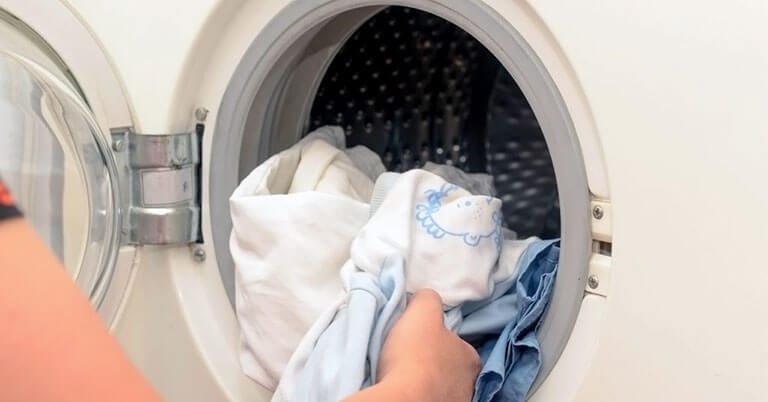Have you ever touched your dryer and noticed it’s warm, even when it’s not running? You’re not alone.
This puzzling occurrence can leave you scratching your head, wondering if something is wrong. It’s a concern that many homeowners face, and understanding why it happens is crucial for your peace of mind and your appliance’s safety. Imagine the potential damage to your dryer, or worse, the risk it poses to your home.
But don’t worry, you’re about to discover the reasons behind this mysterious heat and learn how to prevent any unwanted surprises. By the end of this article, you’ll have the insights needed to keep your dryer—and your home—safe and secure. So, let’s unravel this mystery together and ensure your dryer operates flawlessly.
Common Electrical Issues
A dryer that gets hot when not running might have a faulty thermostat or electrical wiring issue. This can pose a fire risk and needs immediate attention. Regular maintenance and checks are essential to prevent unexpected problems and ensure safety.
When your dryer gets hot even when it’s not running, it can be unsettling. This could be a sign of common electrical issues that need immediate attention. Ignoring these problems can lead to more serious concerns, such as fire hazards or complete appliance failure. So, what could be causing this heat surge? Let’s dive into some typical electrical issues that might be at play.
Faulty Wiring
Faulty wiring is a frequent culprit behind unexpected heat. Imagine flipping a switch and feeling warmth instead of a cool breeze. This might be because the wires in your dryer are frayed or improperly connected. Such wiring issues often arise from wear and tear over time. If your dryer is older, it’s worth considering an inspection. Catching faulty wiring early can save you from expensive repairs and potential safety hazards.
Electrical Short Circuits
An electrical short circuit can also cause your dryer to heat up unexpectedly. A short circuit happens when a path is created that allows electricity to travel along an unintended route. This can generate excessive heat and leave you puzzled about why your dryer feels warm. Short circuits can stem from multiple sources, such as damaged cords or internal issues. It’s crucial to have these inspected by a professional. Left unchecked, they might not only affect your appliance but also pose a risk to your home’s electrical system. Have you ever faced these issues with your dryer? It’s easy to overlook such signs in the hustle of daily life. But taking a moment to address them can protect your home and give you peace of mind. So next time you notice unexpected warmth, consider these electrical issues as potential culprits.
Malfunctioning Components
Unexpected heat from a dryer can point to faulty parts. A broken thermostat may keep heating elements active. Electrical issues might also cause persistent warmth. Regular maintenance helps prevent these problems.
Malfunctioning components can cause your dryer to heat up even when it’s not running. Understanding these issues helps you identify the problem quickly. Knowing what to look for saves time and prevents further damage.
Thermostat Problems
The thermostat regulates the dryer’s temperature. Faulty thermostats fail to detect heat levels accurately. This leads to overheating even if the dryer is off. A malfunctioning thermostat keeps sending power to the heating element. This constant power causes your dryer to heat up unnecessarily. Regular checks can prevent thermostat issues. Inspecting the thermostat ensures it functions correctly. Replace it if necessary to avoid overheating.
Defective Heating Element
The heating element warms the air inside the dryer. A defective element may remain active, causing heat even when the dryer is idle. It continues to draw power from the electrical source. This defect can lead to constant heating, posing safety risks. Checking the heating element is essential. Look for signs of wear or damage. If you find any, replace the element promptly. Proper maintenance of the heating element prevents unwanted heat. Regular inspection is key to a safe and efficient dryer.
Residual Heat Build-up
Have you ever noticed your dryer feels warm even when not in use? This puzzling phenomenon often occurs due to residual heat build-up. Understanding why your dryer retains heat can help maintain safety and efficiency. Let’s explore the main causes of this heat retention in detail.
Heat Retention
Dryers can retain heat even after they stop running. The heated air inside the dryer drum may not dissipate immediately. Insulation around the drum often traps warmth. This keeps the machine warm for a while. Poorly insulated dryers may show more pronounced heat retention. Regular checks on insulation can reduce unwanted heat retention.
Ventilation Problems
Inefficient ventilation is another common culprit. If the vent is blocked, hot air cannot escape properly. This results in heat accumulation inside the dryer. Clean vents ensure smooth airflow, helping release warm air. Check for lint buildup in vents. This simple maintenance task can prevent heat buildup. Proper ventilation keeps your dryer cool when idle.
Environmental Factors
A dryer can feel warm even when off due to environmental factors like room temperature or poor ventilation. Warm air circulates, causing the heat to linger inside the machine. Ensuring proper airflow and keeping the space cool can help prevent this issue.
Environmental factors can play a significant role in why your dryer feels hot even when it’s not running. While it might seem puzzling, the surrounding conditions can sometimes create an unexpected heat buildup. Understanding these can help you identify the source and take appropriate measures.
Ambient Temperature
The ambient temperature in your laundry room can affect your dryer. If the room is particularly warm, it can cause the dryer to retain heat. This is especially true in the summer months or if your laundry area is near a heat source, like a furnace. Warm air can also seep into the dryer, making it feel hot. Consider the placement of your dryer and whether it’s too close to windows or external walls. If you’ve noticed your dryer stays warm even hours after use, it might be worth checking the room’s temperature.
Humidity Impact
Humidity can also be a culprit. Moisture in the air can affect how heat dissipates from your dryer. If you live in a humid climate, this might be more noticeable. High humidity can trap heat, preventing it from escaping your dryer efficiently. Think about whether your laundry room has adequate ventilation. You might find that installing a dehumidifier or improving airflow can make a difference. Have you ever found your dryer warm to the touch and wondered if it’s due to the weather outside? Understanding environmental factors like ambient temperature and humidity can be key. By considering these elements, you can ensure your dryer operates smoothly and efficiently, without unnecessary heat buildup.
Safety Concerns
Your dryer gets hot when not running. This situation may pose safety concerns. Unattended heat can lead to serious issues in your home. Understanding these risks can help you protect your loved ones and property. Let’s explore some safety concerns related to this unusual dryer behavior.
Fire Hazards
Heat in an idle dryer can cause fires. Lint buildup is often the culprit. Lint is highly flammable. When heat accumulates, lint can ignite easily. An unattended dryer with heat can spark a fire. Check your lint trap regularly to reduce this risk.
Faulty wiring may also cause heat buildup. Damaged wires can overheat, leading to sparks. Sparks can ignite nearby materials. Inspect your dryer’s wiring for signs of wear or damage. Professional maintenance can prevent potential hazards.
Preventive Measures
Keep your dryer area clean. Remove lint from the lint trap after each use. Lint can accumulate in the vent as well. Clean the vent pipe regularly to ensure proper airflow. Good airflow reduces heat buildup.
Unplug your dryer when not in use. This simple step can prevent accidental heating. Schedule routine checks with a professional. They can spot issues you might miss. Regular maintenance keeps your dryer safe and efficient.
Install a smoke detector near your laundry area. Early detection can minimize fire damage. It provides an extra layer of safety. Consider adding a fire extinguisher nearby. Be prepared for emergencies.
Why Your Dryer Gets Hot When Not Running [Here is the Troubleshooting Steps]

A dryer getting hot without running might signal a stuck relay or faulty thermostat. Check electrical connections to ensure safety. Identifying the problem early can prevent further damage and maintain efficiency.
When you find your dryer getting hot even when it’s not running, it can be puzzling and concerning. Is it a malfunction, or is there something more subtle at play? Understanding the issue is the first step, but knowing how to troubleshoot it effectively can save you time, stress, and potentially costly repairs. Let’s delve into some practical troubleshooting steps you can take to get to the bottom of this mysterious heat.
Inspection Checklist
Start with a thorough inspection checklist. Begin by unplugging the dryer to ensure your safety. Check for any visible signs of damage like burnt wires or melted components. Make sure the vent is clear of lint build-up. Blocked vents can cause heat to accumulate, leading to overheating. Examine the dryer’s thermostat and timer, as these components can malfunction and cause the dryer to heat up unexpectedly. Do you notice any unusual smells or sounds? These could be clues pointing to the root of the problem.
Professional Assistance
Sometimes, the problem might be beyond a simple DIY fix. If the issue persists after your inspection, it could be time to call in professional assistance. Professional technicians have the tools and expertise to diagnose more complex problems. They can identify issues that might not be visible to the untrained eye, such as electrical faults or internal component failures. Consider the cost versus the benefit of professional help. Sometimes, investing in a professional repair can extend the life of your dryer and save you from having to buy a new one. Have you ever hesitated to call a pro and regretted it later? That experience could guide your decision here. By following these troubleshooting steps, you can better understand what’s happening with your dryer and make informed decisions. Engaging in a systematic approach not only empowers you to take charge but also helps you learn more about how your appliance functions, ensuring it’s running safely and efficiently.
Frequently Asked Questions
What Causes A Dryer To Heat When Off?
A faulty thermostat may cause the dryer to heat. Electrical issues can also be a reason.
Is It Dangerous If My Dryer Gets Hot?
Yes, it can be. It risks fire and damages parts. Immediate inspection is crucial.
How Can I Prevent Dryer Overheating?
Regular maintenance helps. Clean vents and check electrical connections. Replace faulty parts promptly.
Why Does My Dryer Smell Burnt When Not Running?
Burnt smell indicates electrical problems or lint buildup. Check wiring and clean lint traps regularly.
Should I Unplug My Dryer If It Gets Hot?
Unplugging is wise for safety. It prevents further heating and potential fire hazards. Seek professional help.
Conclusion
A dryer getting hot without running can be concerning. Identifying the cause is crucial. It could be a faulty thermostat or wiring. Regular maintenance helps prevent such issues. Cleaning lint traps and vents is essential. Always ensure proper installation and ventilation.
If problems persist, seek professional help. This ensures safety and efficiency. Understanding your appliance helps in quick solutions. Stay informed and proactive. Your dryer will last longer and work better. Keep your home safe and energy-efficient by addressing these issues promptly.
